Ear Diseases
Cholesteatoma
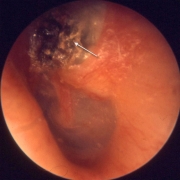 A cholesteatoma is a skin growth that occurs in an abnormal location. The middle ear and the area behind the ear, the mastoid, are the most common areas for cholesteatoma to occur. It usually results from frequent infections and takes the form of a pouch or cyst that expands. Growth or expansion of a cholesteatoma causes damage to the ear drum and ear bones leading to chronic infection and other hearing loss.
A cholesteatoma is a skin growth that occurs in an abnormal location. The middle ear and the area behind the ear, the mastoid, are the most common areas for cholesteatoma to occur. It usually results from frequent infections and takes the form of a pouch or cyst that expands. Growth or expansion of a cholesteatoma causes damage to the ear drum and ear bones leading to chronic infection and other hearing loss.
Cholesteatomas generally require surgery to remove and achieve an infection-free dry ear. Repair of the ear drum and ear bones are also a goal of surgery, however, sometimes two or more surgeries are required to ultimately control a large cholesteatoma.
Chronic Otitis Media with Effusion
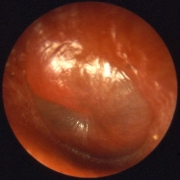 In chronic otitis media with effusion (middle ear fluid), the middle ear area has filled with fluid. This fluid prevents sound transmission to the inner ear resulting in a conductive hearing loss. There are many causes of middle ear fluid but the two most common reasons are recurrent ear infections and chronic Eustachian tube dysfunction.
In chronic otitis media with effusion (middle ear fluid), the middle ear area has filled with fluid. This fluid prevents sound transmission to the inner ear resulting in a conductive hearing loss. There are many causes of middle ear fluid but the two most common reasons are recurrent ear infections and chronic Eustachian tube dysfunction.
If the fluid has been present long enough and medical therapy has not helped, PE tubes are often used to remove the fluid and restore hearing. In the case of Eustachian tube dysfunction, further testing may be required in some instances.
External Otitis
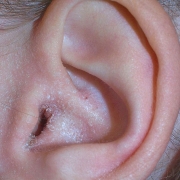 External otitis is an inflammation and infection of the skin of the external ear canal. Often associated with water and swimming, other causes such as allergies, trauma and hearing aid use may also lead to external otitis.
External otitis is an inflammation and infection of the skin of the external ear canal. Often associated with water and swimming, other causes such as allergies, trauma and hearing aid use may also lead to external otitis.
Treatment usually involves medicated drops and cleaning the ear. If there is too much swelling of the ear canal a wick is placed in the ear to assure the drops get to the deep part of the ear canal. Oral antibiotics are not usually needed. Sometimes a fungus causes the infection and different topical medications may be used.
Rarely in diabetic patients an external ear infection can be serious and life threatening. These patients require rapid and aggressive therapy in order to control the infection.
Otosclerosis
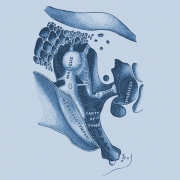 Otosclerosis is an inherited disease that most often causes a type of reversible hearing loss called conductive hearing loss. Although inherited, it does not affect everyone in a family and often skips a generation. When the hearing loss is conductive, it is caused by small areas of hard bone (sclerosis) laid down around the smallest middle ear bone, the Stapes. If the sclerosis spreads to the inner ear, this may cause a sensorineural hearing loss.
Otosclerosis is an inherited disease that most often causes a type of reversible hearing loss called conductive hearing loss. Although inherited, it does not affect everyone in a family and often skips a generation. When the hearing loss is conductive, it is caused by small areas of hard bone (sclerosis) laid down around the smallest middle ear bone, the Stapes. If the sclerosis spreads to the inner ear, this may cause a sensorineural hearing loss.
Treatment includes watchful waiting in early and mild cases. Hearing aids often help both patients with a conductive or sensorineural type of hearing loss. When the hearing loss is predominately conductive, a surgery called a Stapedectomy may be helpful. Surgery for otosclerosis generally involves using a laser to remove the stapes ear bone and replace it with an artificial one. This surgery usually reverses the conductive hearing loss.
Perforated Ear Drum / Tympanoplasty
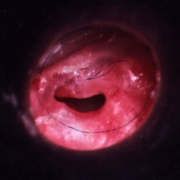 The eardrum or tympanic membrane is a thin layer of tissue that separates the ear canal and the middle ear. It helps to amplify sound to the inner ear. A perforation of the eardrum is a hole in this thin membrane. Often a perforation causes a hearing loss if it is large enough.
The eardrum or tympanic membrane is a thin layer of tissue that separates the ear canal and the middle ear. It helps to amplify sound to the inner ear. A perforation of the eardrum is a hole in this thin membrane. Often a perforation causes a hearing loss if it is large enough.
Causes of perforation are usually infection or trauma. Sometimes PE tubes can leave a hole in the eardrum after they fall out. Most eardrum perforations heal spontaneously within a few weeks to several months. Those perforations that do not heal may require a surgery to repair.
A Tympanoplasty is a surgery to repair the tympanic membrane, usually with the patient’s own tissue. Often a covering of muscle (fascia), or the covering of cartilage (perichondrium), is used to lay under the tympanic membrane and allow it to heal.
Tinnitus
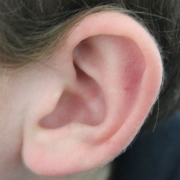 Tinnitus is the perception of a sound without an external source. Ten to fifteen percent of adults report tinnitus resulting in over 50 million Americans experiencing tinnitus. Tinnitus has many causes. Hearing loss of any etiology is a common cause of tinnitus and can be diagnosed with a hearing test. Other causes of tinnitus are more difficult to determine and may require further testing to make sure a more serious problem does or does not exist.
Tinnitus is the perception of a sound without an external source. Ten to fifteen percent of adults report tinnitus resulting in over 50 million Americans experiencing tinnitus. Tinnitus has many causes. Hearing loss of any etiology is a common cause of tinnitus and can be diagnosed with a hearing test. Other causes of tinnitus are more difficult to determine and may require further testing to make sure a more serious problem does or does not exist.
Sometimes treating the underlying hearing loss can help reduce the annoyance of tinnitus. Currently there are no medications that treat tinnitus, however, patients may benefit from education, counseling, behavioral therapy and sound therapy. Most often patients are reassured that there is no serious problem and are able to cope and adapt to tinnitus as a minor problem.
